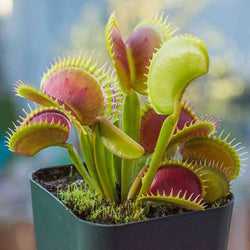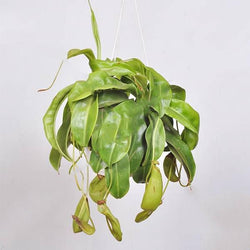Collection: Carnivorous Plants
- Venus Flytrap, Dionaea muscipula - Plant
 (74)
(74)- Regular price
- ₹ 279
- Sale price
- ₹ 279
- Regular price
-
₹ 0
Sold out - Pitcher plant, Nepenthes alata (hanging basket)- Plant
 (97)
(97)- Regular price
- ₹ 629
- Sale price
- ₹ 629
- Regular price
-
₹ 0
Sold out
Carnivorous Plants Collection
Discover the fascinating world of carnivorous plants, where nature's ingenuity meets botanical beauty. Our curated collection features a variety of unique species, including the iconic Venus Flytrap, the elegant Pitcher Plant, and the intriguing Sundew. Each plant is not only a stunning addition to your home or garden but also a conversation starter that showcases the wonders of evolution and adaptation.
What makes carnivorous plants special is their ability to thrive in nutrient-poor environments by capturing and digesting insects. These remarkable plants have evolved specialized mechanisms to lure, trap, and digest their prey, making them a captivating study for botany enthusiasts and nature lovers alike. With their vibrant colors and unusual shapes, they add a touch of exotic flair to any space.
Growing carnivorous plants can be a rewarding experience. They require specific care to thrive, including the right soil, humidity, and light conditions. Whether you're a seasoned gardener or a curious beginner, our collection provides the perfect opportunity to explore the unique needs of these extraordinary plants.
Growing Instructions
- Use a well-draining, acidic soil mix (such as sphagnum moss or peat-based soil).
- Provide bright, indirect sunlight for at least 12 hours a day.
- Maintain high humidity levels (around 50-70%) for optimal growth.
- Water with distilled or rainwater to avoid mineral buildup.
Care Instructions
- Feed your plants live insects or specialized carnivorous plant food every few weeks.
- Avoid fertilizing too often; these plants thrive in nutrient-poor conditions.
- Monitor for pests and diseases, and remove any dead leaves promptly.
- Repot every 1-2 years to refresh the soil and promote healthy growth.
Uses
- Ideal for educational purposes in schools and botanical gardens.
- Great for indoor gardening enthusiasts looking for unique houseplants.
- Can help control insect populations naturally.
Fun Facts
- Carnivorous plants can digest their prey in as little as 20 minutes.
- The Venus Flytrap is native to the wetlands of North and South Carolina.
- Some species can survive for months without food by relying on stored energy.
Scientific and Historical Insights
Carnivorous plants have evolved over millions of years, adapting to thrive in nutrient-deficient environments. They belong to various families, including Droseraceae (Sundews) and Sarraceniaceae (Pitcher Plants). These plants have developed unique trapping mechanisms, such as snap traps, pitfall traps, and adhesive traps, to capture their prey effectively. Their fascinating adaptations have made them a subject of scientific research, shedding light on evolutionary biology and ecology.
Historically, carnivorous plants have intrigued botanists and naturalists since the 18th century. Charles Darwin famously studied these plants, recognizing their complex mechanisms as a testament to natural selection. Today, they play a crucial role in their ecosystems, helping to control insect populations and contributing to biodiversity. By cultivating carnivorous plants, you not only enjoy their beauty but also support environmental conservation efforts.


